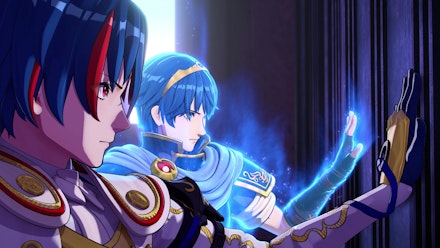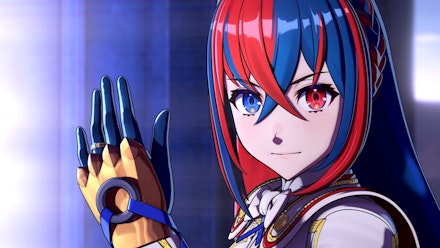Platforms: Nintendo Switch
After a thousand years of slumber, the Divine Dragon, Alear, is awoken to defend the realm of Elyos from their opposite number, the Fell Dragon. Travelling the four nations of the world, Alear must gather allies from each country and reclaim the twelve Emblem Rings, each housing the power of a hero from another world, in order to restore peace once more.
A typically high fantasy state of affairs for Fire Emblem Engage, then – the latest entry in Nintendo’s long-running turn-based strategy/RPG series. Like its predecessors, Engage serves up a satisfying mix of tactical battles across some brilliantly devised maps, and excels in making you feel like a strategic genius with every victory.
However, it also leans into the history of the franchise more than ever, with those aforementioned Emblems being key figures from past games, now able to combine with Engage’s new cast for devastatingly powerful moves. For instance, Alear can merge with Emblem Marth, the embodiment of the very first Fire Emblem protagonist, to gain the ability to unleash a flurry of blows in a single attack. The Emblems being past heroes is borderline fan service – albeit of a curious sort, given the series’ piecemeal availability in the West means several of them will scarcely register – but with a variety of powers and attacks to mix and match with active heroes, it adds up to a meaningful addition to the game’s mechanics.

It’s not only the ethereal add-on heroes that hark back to the past, though. Where 2019’s Fire Emblem: Three Houses shifted the series’ formula slightly, with its three-way conflict and deep webs of social interactions between battles, Engage is almost a return to Fire Emblem classic. The emphasis is firmly on martial prowess, with a significant degree of specificity in roles and abilities – and even the return of the rock-paper-scissors style system of weapon vulnerabilities, where swords beat axes, axes trounce spears, and spears top swords. Outside of combat, the narrative once again follows a more typical ‘heroes vs villains’ arc, while the relationship management side feels far simpler.
The real evolutions are to be found in how much flexibility and customisation Engage offers players in building their army and preparing for battles.
That’s not to say there’s no social aspect whatsoever, though. The familiar mechanic of placing units next to each other in combat to increase unity returns – and between battles, you’ll return to a secluded base called the Somniel, where Alear can chat to allies, host meals, or give them gifts to further raise affinity. When two characters get close enough, you’ll be treated to cutscenes exploring their relationships, building a better sense of who each of your allies is and how they relate.
However, while it’s as tactically prudent as ever to foster these relationships, with higher affinity leading allies to defend each other or join in on attacks to deliver a game-changing extra few points of damage, the characters themselves and their arcs feel flatter than in earlier games. Almost without exception, every ally is the character archetype they first present as, and no amount of backstory deepens their personality or expands their role. Uncertain steward Clanne remains ever-shy, his sister Flamme never really drops her fan-girl obsession for Alear, Prince Alfred of the Kingdom of Firene is a perpetual himbo – on and on, Engage’s cast is full of likeable but unsurprising figures.

Instead, the real evolutions are to be found in how much flexibility and customisation Engage offers players in building their army and preparing for battles. Each visit to the Somniel isn’t just a chance to chat to your mates, but to take part in strength training for stat bonuses in the next battle, boost ally experience in automated Arena battles, stock up on pivotal items, or upgrade weapons. At every turn, the game offers you ways in which to tweak each unit, from their loadouts to their abilities, each decision playing a potentially crucial role in combat. The downside is that each return to the base rapidly begins to feel like running through a checklist of repetitive tasks, but for those willing to put in the effort, the benefits to Fire Emblem’s battles will be keenly felt.
More pointedly, the way in which new weapon specialisations or character classes are learned has been totally overhauled, tying the whole system into the mythologised Emblem characters. When a playable ally builds a bond with an Emblem hero – either through wearing their signature ring into battle, or through taking part in various training activities on the Somniel – they’ll be able to inherit skills from them, allowing the use of weapons they can’t initially equip. For instance, pair magic-using Clanne with Emblem Marth, and he’ll eventually gain the ability to use swords as well as mystic tomes. That in turn allows him to change class to Mage Knight, with proficiency in both weapon styles and more varied moves to use on the field. The system may feel slightly overwhelming at first, not helped by the game’s text-heavy menu layouts and some unintuitive placements for character management, but once you’ve gotten a handle on how to develop and tweak classes, Fire Emblem Engage reveals itself as one of the most flexible and customisable entries in the series’ history.
While there are only the signature Emblem characters to be actively paired with, Bond Rings can also be forged. These secondary power-ups are infused with the essences of other heroes from each Emblem’s source game, offering stat boosts but no merged Engage attacks. There’s a bit of a gacha-game element at work here, possibly inspired by the blind roll mechanics of mobile spin-off Fire Emblem Heroes, in that you have no way of knowing which Bond Rings will be crafted, but thankfully, the only cost is the fairly plentiful Bond Fragment resource. Nothing is wasted either – duplicate Bond Rings can be merged into more powerful versions with enhanced stats. The randomness may frustrate, especially if you’re trying to level up a particular ring and not getting the drops you need to do so, but at least it’s only a time cost rather than real money microtransactions, and it does ensure every ally you take into battle can have some level of bling-based boost.
Along with a few other quality of life tweaks, such as doing away with weapon durability (with the exception of spell-casting staves that deplete with each use) and the ability to more easily rewind bad moves in combat to try again without having to reload the entire game, Fire Emblem Engage is the strongest entry developer Intelligent Systems has offered players in years – at least on the combat front. The straightforward narrative and the more simplistic character arcs may disappoint those who preferred the almost Persona degree of relationship management introduced in Three Houses, but for Fire Emblem purists, this is a high point for the series.
